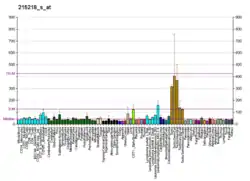WDR62
WD repeat-containing protein 62 is a protein that in humans is encoded by the WDR62 gene.[5][6]
Clinical relevance
Mutations in the WDR62 gene cause of a wide spectrum of severe cerebral cortical malformations including microcephaly,[7] pachygyria with cortical thickening, hypoplasia of the corpus callosum,[5] polymicrogyria as well as microlissencephaly.[8]
In 2018 Xu et al. showed that WDR62 stability and neurogenesis is regulated by MEKK3 in coordination with FBW7 (F-box and WD repeat domain-containing protein 7).[9] In addition, Shohayeb et al. revealed a relationship between the cortical malformation, associated with WDR62 point mutations occurring in humans (V65M and R438H), and ciliopathies. These WDR62 point mutations drive ciliary disruption in Radial glial cell via disrupting the cilia and centrosome localization of CENPJ and the Intraflagellar transport protein 88 (IFT88), which are required for tubulin requitment to centrosome and transport of tubulin to the cilia tip, respectively.[10] WDR62 has been also shown to have a regulatory role on hippocampus development and neurogenesis.[11]
WDR62 is a scaffold protein and interacts with different kinases. Prinz et al. showed a significant role for WDR62 in mediating activation of the JNK pathway in response to TNFα. This finding might have implications in the research of TNFα related diseases such as autoimmune diseases and cancer.[12] It has been also shown that WDR62 upregulation can lead to overproliferation of glia cells and potentially glioma and this is coupled with an upregulation in AURKA, AKT, MYC and PI3K signalling.[13]
References
- GRCh38: Ensembl release 89: ENSG00000075702 - Ensembl, May 2017
- GRCm38: Ensembl release 89: ENSMUSG00000037020 - Ensembl, May 2017
- "Human PubMed Reference:". National Center for Biotechnology Information, U.S. National Library of Medicine.
- "Mouse PubMed Reference:". National Center for Biotechnology Information, U.S. National Library of Medicine.
- Bilgüvar K, Oztürk AK, Louvi A, Kwan KY, Choi M, Tatli B, Yalnizoğlu D, Tüysüz B, Cağlayan AO, Gökben S, Kaymakçalan H, Barak T, Bakircioğlu M, Yasuno K, Ho W, Sanders S, Zhu Y, Yilmaz S, Dinçer A, Johnson MH, Bronen RA, Koçer N, Per H, Mane S, Pamir MN, Yalçinkaya C, Kumandaş S, Topçu M, Ozmen M, Sestan N, Lifton RP, State MW, Günel M (September 2010). "Whole-exome sequencing identifies recessive WDR62 mutations in severe brain malformations". Nature. 467 (7312): 207–10. Bibcode:2010Natur.467..207B. doi:10.1038/nature09327. PMC 3129007. PMID 20729831.
- "Entrez Gene: WDR62 WD repeat domain 62".
- Bhat V, Girimaji SC, Mohan G, Arvinda HR, Singhmar P, Duvvari MR, Kumar A (December 2011). "Mutations in WDR62, encoding a centrosomal and nuclear protein, in Indian primary microcephaly families with cortical malformations". Clinical Genetics. 80 (6): 532–40. doi:10.1111/j.1399-0004.2011.01686.x. PMID 21496009. S2CID 45190332.
- Murdock DR, Clark GD, Bainbridge MN, Newsham I, Wu YQ, Muzny DM, Cheung SW, Gibbs RA, Ramocki MB (September 2011). "Whole-exome sequencing identifies compound heterozygous mutations in WDR62 in siblings with recurrent polymicrogyria". American Journal of Medical Genetics Part A. 155A (9): 2071–7. doi:10.1002/ajmg.a.34165. PMC 3616765. PMID 21834044.
- Xu D, Yao M, Wang Y, et al. (December 2018). "MEKK3 coordinates with FBW7 to regulate WDR62 stability and neurogenesis". PLOS Biology. 16 (12): e2006613. doi:10.1371/journal.pbio.2006613. PMC 6347294. PMID 30566428.
- Shohayeb B, et al. (January 2020). "The association of microcephaly protein WDR62 with CPAP/IFT88 is required for cilia formation and neocortical development". Human Molecular Genetics. 29 (2): 248–263. doi:10.1093/hmg/ddz281. PMID 31816041.
- Shohayeb B, et al. (September 2020). "The Spindle-Associated Microcephaly Protein, WDR62, Is Required for Neurogenesis and Development of the Hippocampus". Frontiers in Cell and Developmental Biology. 8 (549353): 85–98. doi:10.3389/fcell.2020.549353. PMID 3042990. S2CID 221589571.
- Prinz E, et al. (October 2018). "WDR62 mediates TNFα-dependent JNK activation via TRAF2-MLK3 axis". Molecular Biology of the Cell. 29 (20): 2470–2480. doi:10.1091/mbc.E17-08-0504. PMC 6233063. PMID 30091641.
- Shohayeb B, et al. (July 2020). "Elevated levels of Drosophila Wdr62 promote glial cell growth and proliferation through AURKA signalling to AKT and MYC". Biochimica et Biophysica Acta (BBA) - Molecular Cell Research. 1867 (7): 118713. doi:10.1016/j.bbamcr.2020.118713. PMID 32246948.
Further reading
- Bonaldo MF, Lennon G, Soares MB (1997). "Normalization and subtraction: two approaches to facilitate gene discovery". Genome Research. 6 (9): 791–806. doi:10.1101/gr.6.9.791. PMID 8889548.
- Ota T, Suzuki Y, Nishikawa T, et al. (2004). "Complete sequencing and characterization of 21,243 full-length human cDNAs". Nature Genetics. 36 (1): 40–5. doi:10.1038/ng1285. PMID 14702039.
- Grimwood J, Gordon LA, Olsen A, et al. (2004). "The DNA sequence and biology of human chromosome 19". Nature. 428 (6982): 529–35. Bibcode:2004Natur.428..529G. doi:10.1038/nature02399. PMID 15057824.
- Beausoleil SA, Jedrychowski M, Schwartz D, et al. (2004). "Large-scale characterization of HeLa cell nuclear phosphoproteins". Proceedings of the National Academy of Sciences. 101 (33): 12130–5. Bibcode:2004PNAS..10112130B. doi:10.1073/pnas.0404720101. PMC 514446. PMID 15302935.
- Gerhard DS, Wagner L, Feingold EA, et al. (2004). "The status, quality, and expansion of the NIH full-length cDNA project: the Mammalian Gene Collection (MGC)". Genome Research. 14 (10B): 2121–7. doi:10.1101/gr.2596504. PMC 528928. PMID 15489334.
- Rual JF, Venkatesan K, Hao T, et al. (2005). "Towards a proteome-scale map of the human protein-protein interaction network". Nature. 437 (7062): 1173–8. Bibcode:2005Natur.437.1173R. doi:10.1038/nature04209. PMID 16189514. S2CID 4427026.
- Nousiainen M, Silljé HH, Sauer G, et al. (2006). "Phosphoproteome analysis of the human mitotic spindle". Proceedings of the National Academy of Sciences. 103 (14): 5391–6. Bibcode:2006PNAS..103.5391N. doi:10.1073/pnas.0507066103. PMC 1459365. PMID 16565220.
- Olsen JV, Blagoev B, Gnad F, et al. (2006). "Global, in vivo, and site-specific phosphorylation dynamics in signaling networks". Cell. 127 (3): 635–48. doi:10.1016/j.cell.2006.09.026. PMID 17081983. S2CID 7827573.




